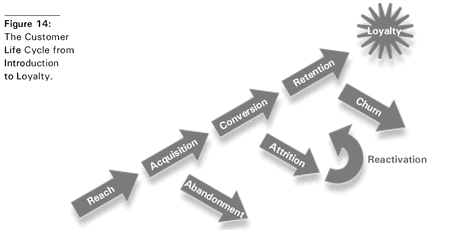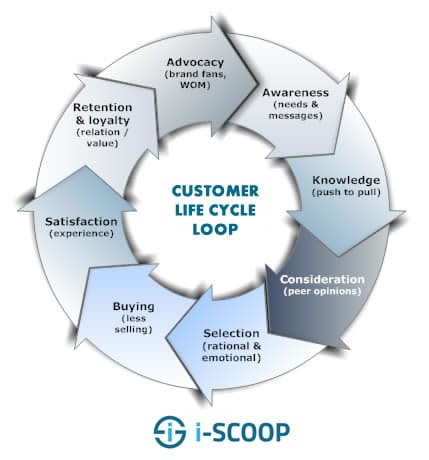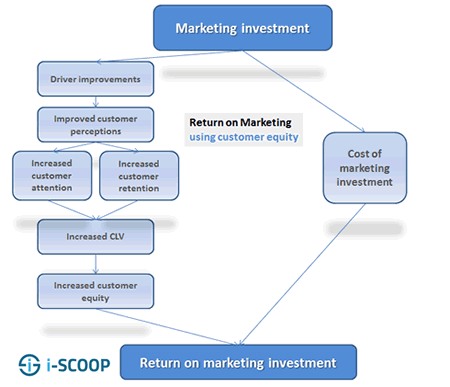The customer life cyle and models to calculate the customer lifetime value (CLV).

The customer life cycle comes from the practice of CRM where it’s traditionally used to map the different stages a customer goes through from considering a product, service or solution to the actual buy and, at least as important, the post-purchase stages (where customer retention, customer loyalty and advocacy come in). It is used in different business functions, including marketing and the management/optimization of the customer experience.
The Customer Lifetime Value (CLV) is a prediction of the total value (mostly expressed in net profit) generated by a customer in the future across the entire customer life cycle. CLV also comes from a CRM and database marketing background. However, it’s used more often in customer-centric and integrated marketing and in a customer experience context, whereby the focus is on long-term customer relationships, as is the case in the end-to-end customer experience.
Using the customer life cycle and customer lifetime value offers several benefits, among others regarding budgeting, segmentation, prioritization and different circumstances where the “health” of the organization can be forecasted – and improved. No wonder it’s also high on the agenda of C-level executives and that the CLV is one of the domains where predictive analytics using big data play an increasing role. Last, but not least, CLV and the customer life cycle play a role in marketing ROI as you’ll read below.
The classic view on the customer life cycle in a digital context
There are different stages in the customer life cycle and there are various methods to define them. One approach is that of Jim Sterne and Matt Cutler, as published in 2000 in a paper called “E-Metrics, Business Metrics For The New Economy” (PDF opens).
There are also different ways of calculating the customer lifetime value (CLV). An introduction.
In the mentioned paper, Sterne and Cutler divided the phases of the customer life cycle (later other elements were added that were more based upon the customer interaction), and to be more precise, the actions we can take in order to engage them through the customer life cycle, as follows:
- Reach: trying to get the attention of the people we want to reach.
- Acquisition: attracting and bringing the reached person into the influence sphere of our organization.
- Conversion: when the people we reach or have a more established relationship with, decide to buy something from us.
- Retention: trying to keep the customers and trying to sell them more (cross-selling, up-selling).
- Loyalty: we would like the customer to become more than a customer: a loyal partner and even a ‘brand advocate’, nowadays also often including so-called influencers

Tip for those leveraging influencer marketing (close to everyone nowadays): when looking for influencers in these days of digital influence, don’t (just) look at the scores of social influencers as the strongest brand advocates might sit right under your nose: the loyalists and the ‘regular Joe’ brand advocates, including your customers and their family, friends and colleagues, all remaining remain key influencers in buying decisions – and obviously your own staff, external partners and more who aren’t on Twitter all day.
Buyer journeys and customer relations are more than models
Of course, models are models and the interaction and buying patterns, as well as conversion paths, are often more complex in a multi-channel world than the models we use to capture them.
The customer’s – ever evolving – buyer journey is not linear and funnel models don’t match with an increasingly complicated behavior, that necessitates a fully connected or integrated marketing 2.0 approach. Certainly with the advent of social media people have more choice and power. Now they are in the influence sphere of your business, next they are not. Since Sterne and Cutler came up with their model, many other representations of the customer life cycle were made.

It’s nearly impossible to fully monitor buying journeys and decisions. You don’t know if a new customer saw your billboard, you don’t know if his friend advised him to buy your products, and you don’t know all the online and offline channels, he used to inform himself and even interact with you or your agents or resellers if you have a channel go-to-market model.
He might have been called by your internal sales team and next be visited by an external sales rep or contacted via a partner, while he told the internal sales rep he was not interested in working with your company. Sounds familiar? Disconnected systems and processes? Silos? If only you had a more holistic and customer-centric customer view… With the advent of new ways of interacting, the disconnect only becomes bigger.
And what about existing customers? Do you know them well enough? Are you sure there isn’t a customer with an extremely high buying potential that sits there in your small accounts because he only buys from you when your competitor is out of stock? What about churn? Does the customer come back?
The Customer Lifetime Value (CLV) is a prediction of the total value (mostly expressed in net profit) generated by a customer in the future across the entire customer life cycle
The customer life cycle in a connected reality
It’s important to understand your prospects and customers throughout their entire journey and life cycle, and, at least, to know what happens with them through all contact moments and touchpoints between them and your company (and the people working for and in it).
The customer life cycle hasn’t changed that much but the ways to achieve reach, acquisition, conversion, retention, loyalty, advocacy have. There are more options for both customers and marketers. And at the same time more challenges. The same goes for the measurement of the customer lifetime value.
Still, having an overall view and matching the different stages in the customer life cycle with the direct and indirect signals, needs and emanations of intent, in alignment with the brand dimension, is crucial. It goes beyond the individual marketing campaign, channel and tactic. And it’s one of the reasons we like to look at customers as people in a connected perspective. It’s also one of the reasons why marketing automation, in combination with CRM, became so popular. However, we see that in general there is still a lot of focus on using such tools (that are getting new names for a reason) in a disconnected and often limited and campaign-centric way.
When we look at the overall customer life cycle it’s clear that there are several threads running across each stage and thus also each layer of the proverbial funnel: think about the use of content that meets customer intent and needs (content marketing), for instance. Content marketing can hardly be called a marketing discipline as such as content plays a role in all stages, from reach to advocacy and beyond. The same goes for social media marketing. And, yes, even email marketing and some more traditional forms of marketing. The list goes on indeed. When we look at individual touchpoints first and then about tactics and channels, we can start having a more integrated view as well and connect the dots of business goals, buying journey, sales cycle, customer experience, channels, content and the key part of the equation: the customer.
Customer Lifetime Value (CLV): introduction and measurement
Back to the beginning: customers “have” a life cycle. And businesses know it. The question they have been asking themselves for ages is how you can define the CLV of your customer portfolio and even of specific customer groups or individual customers. There are many models to do that as well. The customer lifetime value (CLV) is a financial metric used to look at customer profitability and, when properly calculated, a potential impact on the different marketing efforts across the customer’s life cycle. Just like marketing ROI or Return on Marketing Investment it is a financial value. It is advised to use CLV in order to create value across the customer life cycle.
The value of the customer lifetime looks at the investments we plan to make for the customers (retention, sales, promotion, customer service, whatever) and the return we expect from them. It’s a forward-looking indicator that has everything to do with the present and the future. CLV is the present value (expressed in your local currency) of the expected future cash flows from the customer.
The problem with calculating the CLV this way is that it happens from a global perspective (customer base), and it is difficult to use to calculate the value of the CLV on micro levels like a marketing plan. Furthermore, CLV calculation models often find their origins in rather direct marketing oriented activities and are less useful for customer investments that are more difficult to calculate (think branding, for instance).
Return On Marketing Investment and the CLV

Another way to calculate the value of the customer lifetime starts from the micro-levels, even individual marketing and sales actions. Despite what many unfortunately still believe, it also can be used to calculate and predict the impact of branding related activities. I’m talking about Marketing ROI (or ROMI). And no one looked deeper into it than Jim Lenskold.
ROMI, short for Return On Marketing Investment is based on the incremental return of every USD (or your local currency) extra that is spent in customer-targeted activities (so also future-oriented). It is primarily a financial parameter that can be used for making prognoses and for calculating the efficiency of running marketing and sales programs.
However, in order to be able to do that, you need to have a well-implemented ROMI-program in your company. Although data from ROMI programs offer an excellent way to calculate and follow the value of the customer lifetime bottom-up, there are many hurdles to take.
First of all, few companies use ROMI as a parameter and even fewer use it on all levels, ranging from every individual campaign to the corporate level. Implementing such programs requires many cultural changes in the company and that doesn’t happen overnight. Even with ROMI programs you often will need to make extrapolations, for instance for high-risk customer investments.
The CRM and customer equity perspective
You can also use your CRM programs to calculate the CLV, on a global and often a micro level as well but here too there are many hurdles. An interesting approach, that combines the traditional way of calculating the CLV and Return On Marketing Investment as a financial parameter, is that of the ‘customer equity’, as explained in an article in the Januari 2004 edition of the Journal of Marketing by Roland T. Rust, Katherine N. Lemon and Valarie A. Zeithaml.
In their article, called “Return on Marketing: Using Customer Equity to Focus Marketing,” (PDF opens), the authors describe the ‘Customer equity’ as the sum of all values over the total customer lifetime of a company. Starting from that definition, they developed a framework to optimize the lifelong value of all customer relationships from a CRM perspective.
The ‘customer equity’ is the result of three important underlying parameters:
- the ‘value equity’ (the objective perception of a brand by the customer from a realistic ‘quid pro quo’ viewpoint)
- the well-known ‘brand equity’
- the ‘retention equity’ (that expresses the customer loyalty).
Improving (the value of) the ‘customer equity’ happens by working on and combining the various components (called ‘drivers’) of these three. For instance: you can raise the ‘value equity’ by giving the customer more, by making things easier for him, etc.
Also the role of customer segmentation is important. The authors state that segmenting your customers should be done from the viewpoint of the long-term potential of the customers. Finally, the article underlines the importance of ‘brand switching’ and even developed a model to calculate the possibility that customers will switch brands.

It’s an interesting, very future-oriented model (and that’s what CLV is about, remember) because of its clear focus on a customer-centric approach (note that ‘brand equity’ is one of the three underlying parameters of ‘customer equity’,’ and that’s a clear message from the authors about customer-centric thinking versus brand-centric thinking), its focus on ROMI and the evident role of customer segmentation.
Many solutions and many questions in calculating CLV
There are other ways to calculate the CLV. They all have their advantages and disadvantages, and much of course depends upon the type of company or industry (for instance: retailer chains versus B2B service firms). All the mentioned and other models have their specific historical roots that can limit their use in certain environments.
Choosing the best way to calculate the CLV depends a lot from the tools you have, the way you calculate your sales and marketing investments and how customer-centric your company truly operates.

